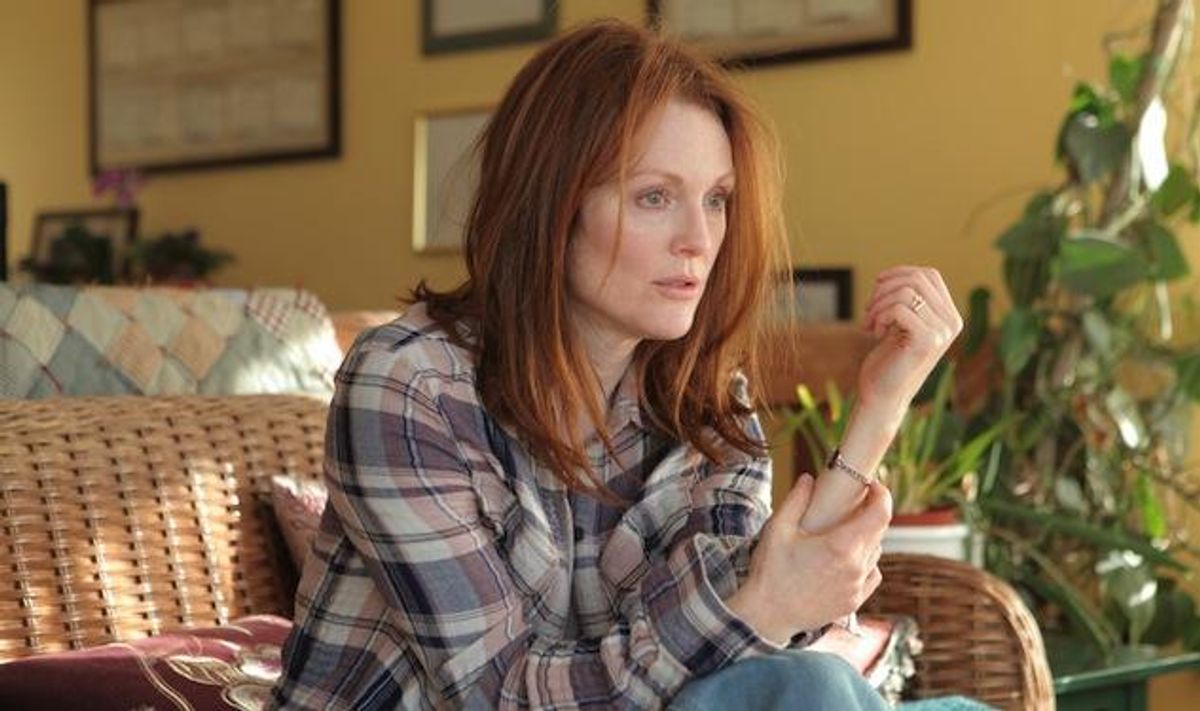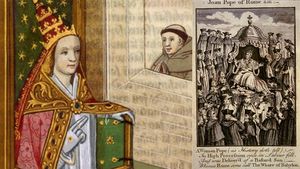
CONTACTAbout UsCAREER OPPORTUNITIESADVERTISE WITH USPRIVACY POLICYPRIVACY PREFERENCESTERMS OF USELEGAL NOTICE
© 2025 Pride Publishing Inc.
All Rights reserved
All Rights reserved
By continuing to use our site, you agree to our Private Policy and Terms of Use.
Some of the best movies by the best gay filmmakers are not about gay people. Think of the legends: Cocteau, Visconti, Almodovar elevated world cinema by extending their sensibilities to address the essence of the human condition as in Orpheus, Bellissima, Senso, White Nights; often by concentrating on universal experiences or a female lead character whose actions and emotions illuminate all relationships as in Women on the Verge of a Nervous Breakdown. That's the model Richard Glatzer and Wash Westmoreland follow in Still Alice.
Julianne Moore plays linguistics professor Alice Howland, a 50-year-old married mother of three, who is diagnosed with Early-Onset Alzheimers Disease. How she suffers the loss of her thinking ("I am defined by my intellect, articulation, language") makes for a story of identifiable sorrow and tenderness. Glatzer and Westmoreland, partners who live together and have made collaborative films since 1994, think and feel outside the gay ghetto. Westmoreland, whose filmmaking apprenticeship includes several porn features, expands their repertoire.
Still Alice's non-frivolous subject has personal significance for the duo (Glatzer was diagnosed with ALS in 2011) but the film is notable for the continually broadened scope of their filmmaking (beginning in 2006 with Quinceanera which observed a teenage Latina's coming of age). Awareness of the larger world is also part of Glatzer and Westmoreland's humanity, their gay humanity, their artistry.
The essential subject matter of art does not change for gay artists. Alice's interactions with husband John (Alec Baldwin), son Tom (Hunter Parrish) and daughters Anna (Kate Bosworth) and Lydia (Kristen Stewart) have the requisite--and recognizable--tonal differences to make their varied personalities credible. Some scenes recall the familial insight of Thomas Bezucha's The Family Stone, another outside-the-gay-ghetto touchstone.
In Still Alice's best scenes, Glatzer and Westmoreland convey the value we place on our human functions and the complexity of family tensions. They casually and pointedly detail Alice's life habits: teaching, cooking, cleaning, speaking--everyday rituals that foreground and introduce mortality.
Westmoreland and Glatzer engage Alice's dilemma by showing what gay artists have learned from the AIDS crisis about humanity and mortality--from porn to profundity. The AIDS experience has taught the world compassion. That lesson is felt, despite the film's stylistic ordinariness, in Alice's conflicts with rebellious Lydia whose struggling acting career mirrors Alice's clinical struggle with self-expression. Moore and Stewart have complementary acting rhythms with Stewart showing intensely beautiful anger and remorse; she channels it into Lydia's performance of a scene from Chekhov's Three Sisters and her own recitation of a speech from Angels in America, Part II (Perestroika).
Playwright Tony Kushner wrote Angels in America as an attempt to exceed party politics and sexual politics through visionary poetry ("souls were rising, floating up like sky divers in reverse"). He implied that spirituality transcends sexuality and his effort is affirmed when Alice fumbles to describe the play's scope but says "scape." It's a good gaffe because the landscape of gay filmmaking needs precisely the expansion of storytelling territory as Glatzer and Westmoreland demonstrate. That's how Still Alice differs from gay filmmaker Todd Haynes' repugnant Safe (1994), in which Moore also played a heterosexual woman plagued by illness.
Haynes' inability to empathize except with pathological conditions is an artistic disability. It is the opposite of what Cocteau, Visconti and Almodovar have taught; opposite the broad humanity gay director Patrice Chereau showed in Son Frere, which transferred AIDS crisis to a wider experience; opposite Robert Altman's great leap forward into female and gay consciousness in Come Back to the 5 & Dime, Jimmy Dean, Jimmy Dean.
Moore's Alice, struggling with "the art of losing," isn't a high camp virago like a drag version of Bette Davis in Dark Victory or Susan Hayward in Stolen Hours; neither is she a non-camp drip like her role in Haynes' pseudo soap-opera Far From Heaven. Dealing with non-gay experience so sensitively, Glatzer and Westmoreland consider our spirituality. Still Alice awakens our human responses.
Still Alice opens for a one-week awards qualifying run in New York City and Los Angeles on Dec. 5. Watch the trailer below:
From our Sponsors
Most Popular
39 LGBTQ+ celebs you can follow on OnlyFans
November 19 2024 9:39 AM
27 LGBTQ+ reality dating shows & where to watch them
March 24 2025 11:32 AM
21 times male celebrities had to come out as straight
November 19 2024 3:33 PM
17 queens who quit or retired from drag after 'RuPaul's Drag Race'
November 30 2024 12:26 AM
Love is in the air! Unforgettable gay kissing scenes from TV & movies
February 12 2025 3:07 AM
48 steamy celebrity Calvin Klein ads the gays won't forget
March 17 2025 5:42 PM
Murray Bartlett's 8 best gay roles in TV shows & movies
February 12 2025 2:33 PM
29 out & proud LGBTQ+ country artists you should be listening to
April 15 2025 3:21 PM
All the 'Drag Race' queens on OnlyFans (& what they're showing)
March 21 2025 10:57 AM
HIV Is Not a Crime Day: Films about HIV & AIDS that you should watch
February 28 2025 1:23 AM
Latest Stories
Bowen Yang calls JD Vance a 'Pope Killer' on 'The View'
April 25 2025 3:55 PM
When exes blossom in Spring—and how to nip them in the bud
April 25 2025 12:20 PM
20 lesbian movies you probably haven't seen but really should
April 25 2025 10:18 AM
Red Hot Roadtrip: Rev up for 2026 with this calendar of sexy ginger men
April 24 2025 1:55 PM
Walton Goggins goes there in sexy new Speedo pics
April 24 2025 10:14 AM
Lorde is kicking off her new era with a surprise single drop
April 23 2025 4:11 PM
Durand Bernarr reflects on 1st Grammy nomination & supportive parents
April 25 2025 3:38 PM
'Drag Race' winner Venus shares apology video to Mexican people
April 25 2025 11:18 AM
Pete Buttigieg says he met Chasten on the apps—reacts to Grindr surge at RNC claims
April 25 2025 3:02 AM
Why Harvey Fierstein deserves his Tony for Lifetime Achievement
April 24 2025 6:09 PM
Pete Hegseth's Pentagon makeup suite is proof hyper-masc is manhood make-believe
April 24 2025 12:00 PM
BREAKING: George Santos sentenced to hard time in prison
April 25 2025 1:38 PM
Dominic Albano Collection releases sexy new line with hot male models
April 24 2025 6:20 PM
Must-see LGBTQ+ films every straight ally should watch
April 24 2025 4:37 PM
'Drag Race' star Jiggly Caliente lost 'most of her right leg,' family says
April 24 2025 10:26 AM
Here's why Elon Musk is the new Mike 'MyPillow' Lindell
April 24 2025 10:00 AM

















































































